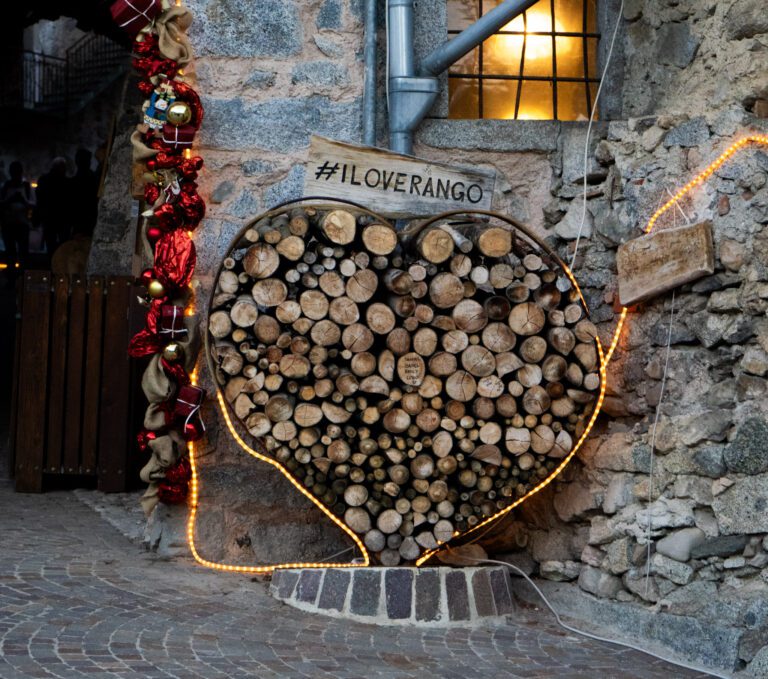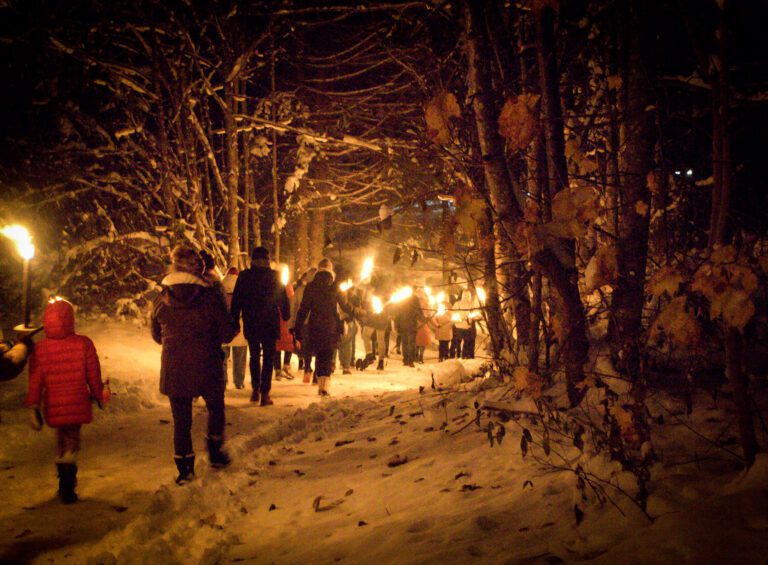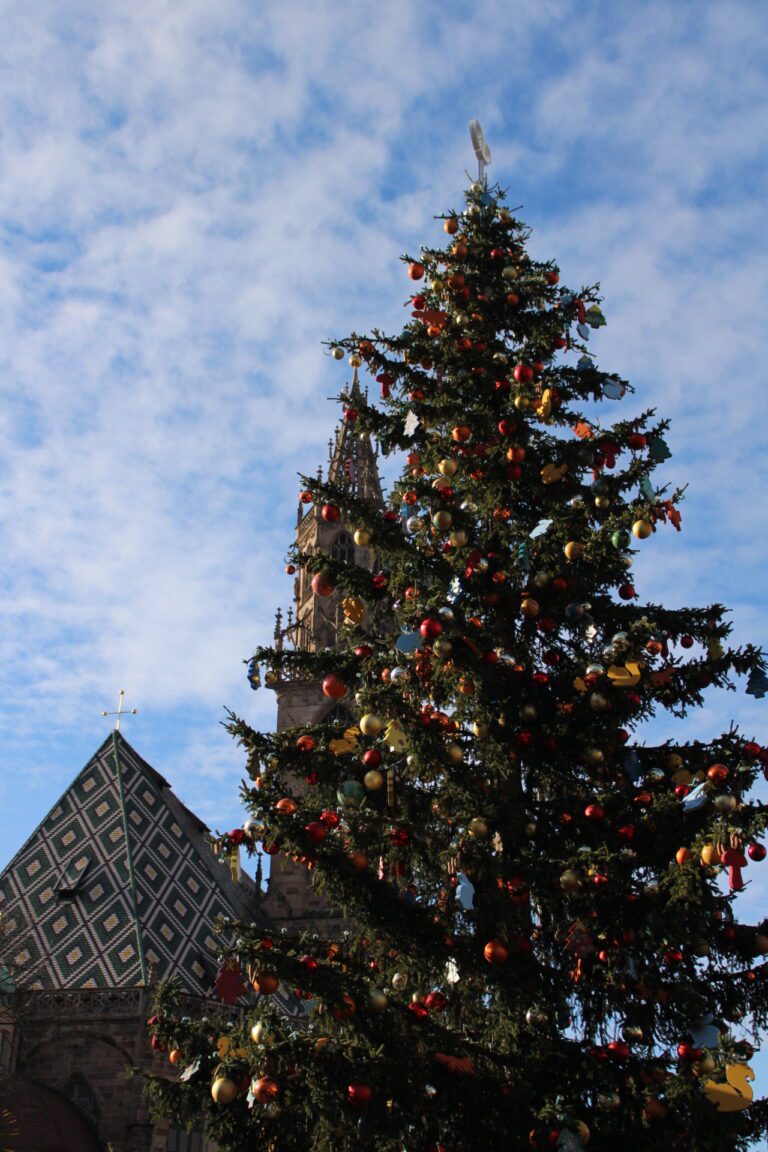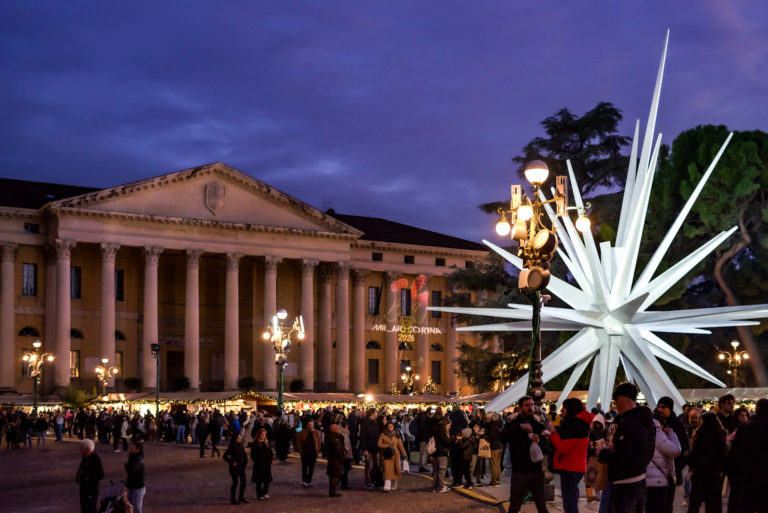Get to Know Krampus and What to expect At A Krampus Run
Krampus, the horned and fearsome companion of St. Nicholas, has long been a figure of folklore in Alpine regions. With his menacing appearance and penchant for punishing naughty children, Krampus serves as a stark contrast to the jolly gift-giving nature of Santa Claus.
As interest in this dark Christmas character grows, many are left wondering: who is Krampus and what can we expect from him during the holiday season?


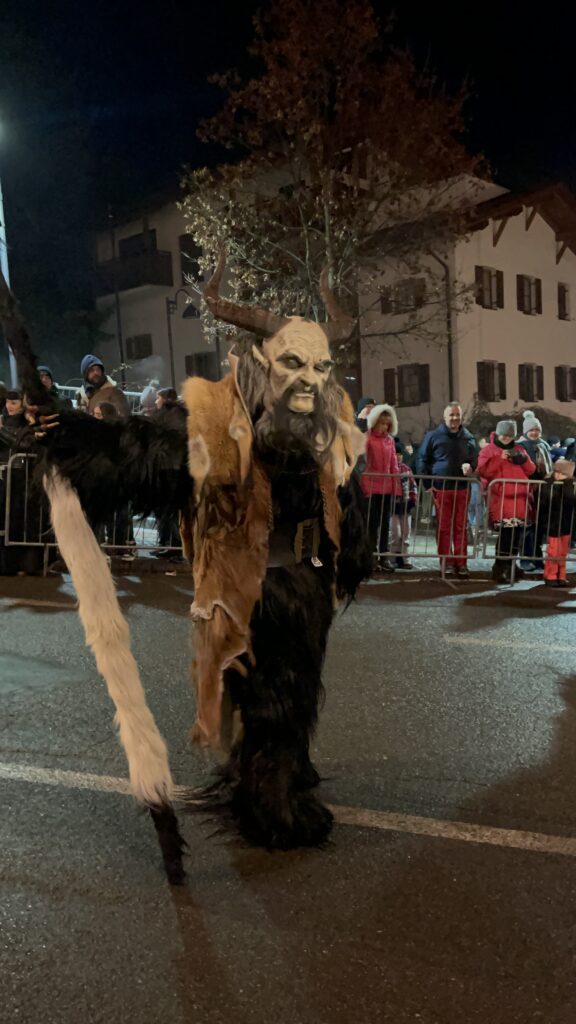
Personal Experience
Last year, I saw about 300 Krampuses march through the town of Kastelruth Castelrotto in Northern Italy or South Tyrol. USAG Italy has an Outdoor Recreational organization that offers tours to the Vicenza Military Community one of which happened to be a Krampuslauf tour. This was perfect because we had just moved from South Korea and we didn’t have our car yet.
While we explored Christmas Markets in South Tyrol, we were eagerly anticipating the rest of the night at the Krampus run in Kastelruth/Castelrotto. What I did not anticipate was how much fun I would have.
For me, it was amazing seeing the local groups of krampuses, locals from villages all over the alpine region, dressed up in homemade, even hand-carved masks. It was remarkable how much energy they had for something so heavy. Some of these masks were unbelievable.
We had a group of kids next to us who were local and knew some of the folks participating in the Krampuslauf. They started taunting most of the Krampus and we all became targets, on the receiving end of the switch or having the barriers shook in front of us.
A small child next to me cried uncontrollably, and at one point, an empathetic Krampus approached her, soothing her fears. Then, with a playful grin, he pulled my beanie down over my face—it was incredibly wild! Instead of pulling their child away, the parents beside me encouraged her to interact with the Krampus. This made me realize that the Krampus legend is deeply rooted in South Tyrolean culture, and children often meet Krampus at a young age. It’s an integral part of their Christmas traditions and lore.
History Of Krampus
Krampus has roots in ancient Alpine traditions, dating back to pre-Christian folklore. Legend has it that Krampus is the offspring of Hel, the Norse goddess of the underworld. As Christianity spread, Krampus became linked to Christmas, despite the Catholic Church’s attempts to suppress his presence. Krampus and St. Nicholas make their appearance on the evening of December 5th, known as Krampusnacht (“Krampus Night”).
The name “Krampus” derives from the German word “Kampen,” which means “claw.” Artists often depict him as a goat-like creature with horns, fangs, and a long tongue, dressed in ragged fur. I’m not exaggerating when I say that those who don the costumes go all out to bring this character to life.
In some portrayals, there is a large woman who whips tiny men with her birch sticks, carrying them off in her satchel. In another depiction, a smiling woman dangles a defeated-looking Krampus in the air, hiding his bundle of birch sticks behind her back.
I of course, think these depictions are hilarious.
What is Krampusnacht?
Ah, Krampusnacht—one of the most thrilling nights on the holiday calendar! Celebrated on December 5th, this evening bursts with folklore, excitement, and a dash of delightful terror. While many people around the world prepare for the cozy, gift-giving festivities of Christmas, others in Central Europe gear up for a very different kind of celebration.
Just to clarify, Krampus runs, or Krampusläufe, can take place any night before or after December 5th!The Origins of Krampusnacht
The term “Krampusnacht” literally translates to “Krampus Night,” and it marks the eve of the feast day of St. Nicholas, which is observed on December 6th. While St. Nicholas is known for his generous spirit—bringing gifts to well-behaved children—Krampus serves as his darker counterpart, embodying the consequences of naughtiness.
According to folklore, this is the night when Krampus roam the streets, bringing a blend of fear and fun. Traditionally, Krampus is depicted as a horned, goat-like creature, covered in fur, with a long tongue and a mischievous grin. Think of him as Santa’s devilish twin, equipped not with a sack of toys but rather a bundle of switches for the naughty ones!
The Celebrations
As night falls on December 5th, communities in Austria, Germany, and parts of Italy gear up for lively festivities. This is no ordinary holiday evening; it’s a full-on spectacle!
Krampus Runs
One of the highlights of Krampusnacht is the Krampuslauf, or Krampus Run, where revelers dress up in elaborate costumes, complete with intricate masks and bells that jingle and jangle. As they parade through the streets, the air fills with a mix of excitement and fear. Picture it: a group of towering Krampuses thundering through town, brandishing chains and switches, while townsfolk cheer, and shriek.
It’s not really people running everywhere it’s more a parade of Krampus going through the street scaring everyone behind barriers. The official tourism website for Naturns, a village near Meran, says that
“Krampus devils nowadays are more constrained in what they can get up to. While the old Krampus runs were a bit of a free-for-all, and one didn’t quite know who had just doled out a beating, the event has been toned down considerably. Supported by local municipal authorities, this old custom has evolved into a folk spectacle and is subject to strict rules. The anonymity of the Krampus is also something of the past. Nowadays, each ‘devil’ has to wear an ID number, allowing traceability in the event of malpractice.”
Community Bonding
Amidst the playful frights, Krampusnacht fosters a strong sense of community. People gather to watch the parade, share hot drinks like mulled wine, and enjoy seasonal treats. You’ll see locals going around with the round coolers full of mulled wine and small cups, and for a small donation, you can get a drink. They even take it a step further and you can get Schnaps.
Mischief and Mayhem: Traditionally, Krampus would visit homes to check on the behavior of children. If they had been naughty, they might find themselves on the receiving end of a playful scare! Folklore suggests that Krampus might leave a switch for poorly behaved children or, more humorously, take them away in his sack—though thankfully, he’s not as terrifying as he sounds.
One of my favorite things I discovered at the Krampuslauf is that anyone who dares to challenge a Krampus earns the title “Tuifeltratzer,” or devil baiter. I learned this when the kids next to me were called that by another onlooker.
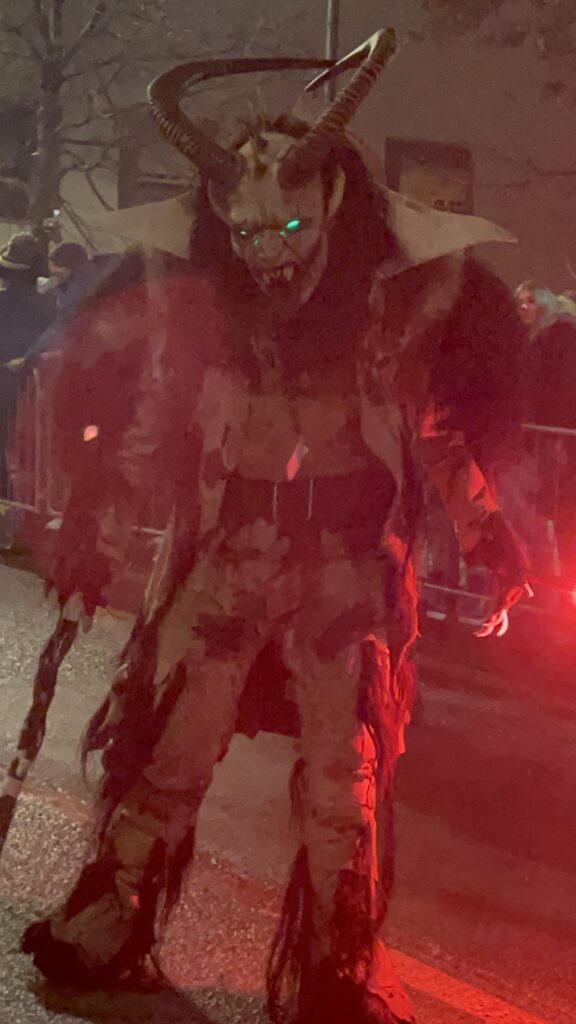

The Cultural Significance
In many ways, Krampus embodies the spirit of old-world folklore—he’s a relic of a time when storytelling held sway over moral lessons, and the line between good and naughty was much clearer (and much more entertaining).
While St. Nicholas rewards nice children by leaving presents, Krampus beats those who are naughty with branches and sticks. I can attest to this, as we were at the Krampuslauf and I got hit with a switch several times.
The lore surrounding Krampus varies by region. In Austria, for instance, he is often described as a playful trickster, while in other areas, he can take on a more menacing role. This duality adds to the charm and mystery of the Krampus legend.
Village-Specific Variations
- Val Gardena: In this region, Krampus is known for his frightening appearance, often described with massive horns, a long tongue, and fur-covered skin. Local stories emphasize how he would roam the streets on the night of December 5th, visiting homes and scaring misbehaving children.
- Merano: In Merano, Krampus is often associated with the region’s winter markets. Folktales recount how he would appear at these markets, engaging with the crowd, and ensuring that children behaved well as they sought sweets from St. Nicholas.
- Brixen (Bressanone): Here, Krampus’s stories often include him carrying chains and bells, which he would rattle to create a terrifying atmosphere. Local legends speak of him lurking in the woods, waiting for naughty children to stray too far from home.
Debunking common myths
Krampus represents the devil
Couldn’t be further from the truth. Krampus is based on Pagan traditions, as previously stated. Remember where the Christian faith is derived from?
Krampuslauf is dangerous
In recent years the Krampuslauf has had a reputation for being rowdy, but remember when I quoted the local tourism website as to why they wear numbers on their costumes? This is to make things traceable. We did see a fight occur after a spectator grabbed a mask. The Krampus had to defend himself because the masks were heavy and the person wearing the costume could get injured.
Keep your hands to yourself and find a place that is comfortable so you don’t have to deal with the Krampus touching you if that is not your thing.
Krampus is not St. Nicholas sidekick
He is very much St. Nicholas sidekick. He is not meant to be terrifying but rather to remind folks that good always prevails. This is according to some associations in Austria. To quote an article from the Guardian
“The aim of the Krampus is not to hurt people,” said Aleksander Andonov, who heads the Anif Krampus Association. “On the contrary: we want to take away their fear. In the end, good always wins over evil.”
It’s all evil and not Christian
I don’t even want to delve into this. Rather, I’ll just say, that just because you don’t understand it doesn’t mean it’s evil. You just need to research the folklore and culture of the area before you dismiss it.
Where to Meet Krampus Christmas 2024:
Since I live close to South Tyrol, I am limiting this section to Northern Italy. I’ll also include websites where you can learn more as I always caution folks to check the websites before you head out!
11/16/24 – Krampus Run in Nova Levante
11/23/24- 3rd Krampus Parade in Bronzolo
12/5/24-St Nicholas Parade in Silandro
11/30/24 -Krampus Parade in Laives
12/5/24- Krampus Parade in Lana Di Sotto
12/5/24- Krampus Parade in Cortaccia
12/7/24- Devils Run in Campo Turres
12/7/24- THE OLDEST KRAMPUS RUN IN TOBLACH*
12/8/24- Catch the Devils at the Market in Bolzano
12/14/24- Krampus Show/Parade in Sesto
Resources
For an extensive list of events give SuedTirol Official Tourism Office a visit
Check out a master craftsman while in South Tyrol, Gerhard Ploner
Conclusion
Have fun out there experiencing the lore of Krampus, and if you’d like, tell me where you are headed to!


